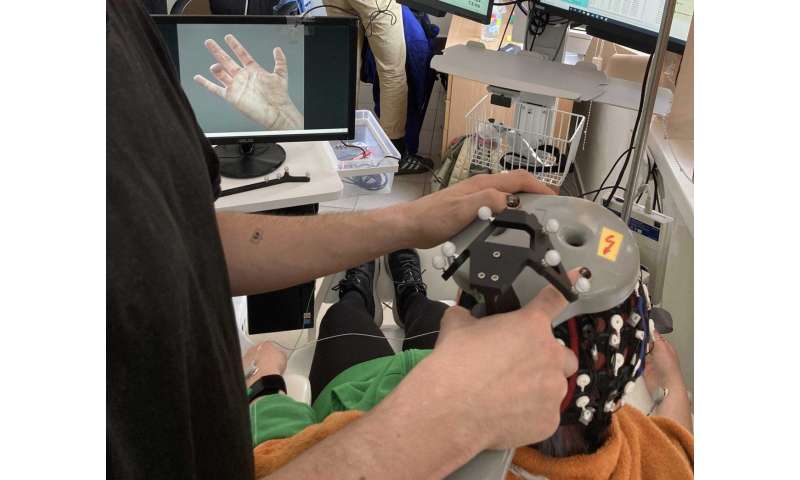Interface 'brain-computer' will speed rehabilitation of patients after stroke

Scientists from the Immanuel Kant Baltic Federal University and Skolkovo Institute of Science and Technology have found that the use of brain-computer interfaces can help speed up the rehabilitation of patients who have suffered a stroke. According to the proposed approach, a person manipulates a virtual limb with the help of mental commands. The observation of the virtual arm's actions, caused by the user's mental efforts, leads to the activation of various brain regions involved in the prediction and control of one's own movements. It will help to reconstruct sensorimotor neural connections destroyed by a stroke. The results of the research will be published in the journal Frontiers in Human Neuroscience.
More than 400 thousand of new cases of a stroke are registered annually in Russia, most of them are fatal cases. Only 8-10% of patients do comparatively fine, recovering rapidly (about during a month) their mobility. Most patients rehabilitate during years and don't always recover at the end. The approach of action observation is widely used as poststroke rehabilitation. It consists in that a patient observes a healthy man making these or those movements, that he can't at his present condition repeat adequately. In the course of observation so-called mirror neurons, that participate in rehabilitation of neural connection destroyed by the stroke, are activated in the brain.
However, the method of observation is not always effective due to the low involvement of patients in such passive training. Besides, observation of actions by an external person is not connected with internal intentions of the patient to make his own movement. That is why scientists consider as an alternative such methods that require active involvement of a patient in the process of rehabilitation. Such "involvement" can be provided, for example, by "brain-computer" interfaces—systems that allow a person to manipulate external electronic devices, such as prostheses or their virtual models, with the help of mental commands. The main idea is that a patient should not only observe another person's movements, but also perform them mentally and see how his thoughts are translated into movements. The observation of the action as a feedback for the mental effort is the same natural contour that is destroyed in the case of paralysis.
Scientists from the Immanuel Kant Baltic Federal University (Kaliningrad), Skolkovo Institute of Science and Technology (Moscow) and Moscow State University (Moscow) studied the activity of the brain of healthy people who, with the help of the "brain-computer" interface, performed the task of controlling the movements of a virtual limb. Scientists placed a monitor in front of the test men, on which a virtual model of an arm was displayed. The participants of the experiment had to mentally move the fingers of this virtual arm by sending commands through the "brain-computer" interface. At the same time, the authors recorded data from the electroencephalogram of the subjects.
The experiment showed that the neural activity at the moment of mental performance of an action, waiting for the result and observing the answer differed in character (different brain regions were activated) and amplitude. Interestingly, at the moment of waiting for an answer (movement of a model) in the brain of participants worked sensorimotor connections that participate in prognosis of muscular action and preparation of movement.
In addition, the authors found patterns of neural activity specific to error actions. They correspond to inhibitory processes in the brain that are observed when a person makes error (unplanned) movements in reality. In addition, observations of stroke patients indicate a decrease in such activity. On this basis it is possible to conclude that the principle of "premeditation" of action before its observation, which is realized during use of interface "brain-computer", can help to restore destroyed neural connections of action monitoring in patients after a stroke.
"Brain-computer interface" can be used in the treatment of a wider range of diseases and disorders, such as cerebro-spinal trauma, Parkinson's disease and others. In the future we plan to enrich the feedback with other sensory modalities, for example, during the action observation there will be also tactile stimulation of the paralyzed limb. It is also necessary to adapt this technology for use in rehabilitation practice, to make the system as simple as possible and available for use by patients",—says Nikolay Syrov, senior research scientist of V. Zelman Center for Neurobiology and Brain Restoration.
More information:
Nikolay Syrov et al, Beyond passive observation: feedback anticipation and observation activate the mirror system in virtual finger movement control via P300-BCI, Frontiers in Human Neuroscience (2023). DOI: 10.3389/fnhum.2023.1180056
Provided by Immanuel Kant Baltic Federal University